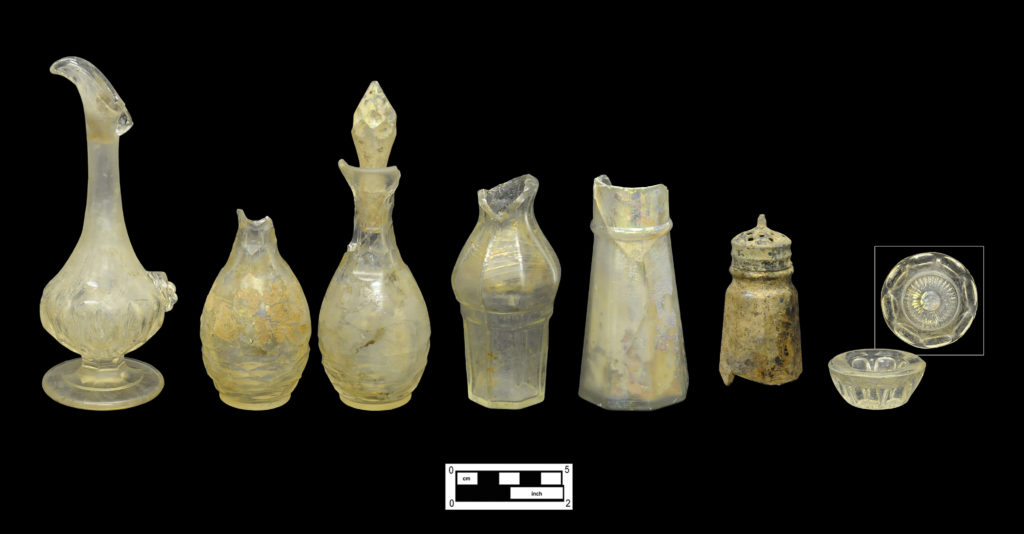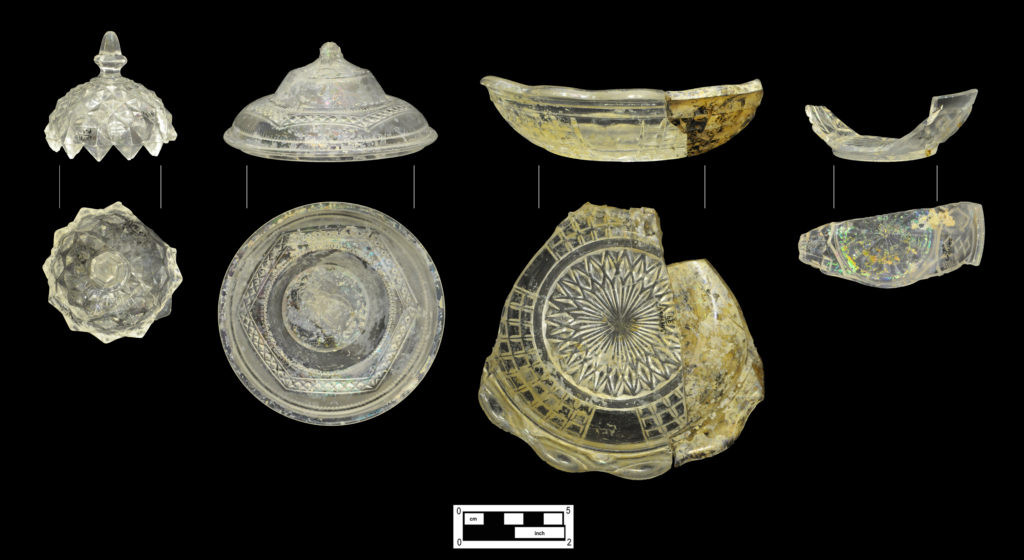Due to the volume of glass tableware recovered from this shaft feature, the topic is divided into two sections. This section discusses the variety of tableware forms that are not related to drinking vessels. Among the glass tableware were several cruets and caster bottles, salt or pepper shakers, and assorted, mismatched dishes and lids. Where possible, we have attempted to identify the patterns by providing the original manufacturer’s designation, if known, or giving the names assigned by later collectors. It should be noted that in some cases, the historic glass catalogs only refer to objects by model numbers.

Condiments for the Table
Glass vessels like those shown here (first four on left) were usually brought to the table in a metal frame called a “caster stand.” By the 1860s, glass salt and pepper shakers were in common use. Prior to that and throughout the nineteenth century, salt was often placed on the table in an open dish. By the late nineteenth century, small, individual salts and butters were fashionable.
Pressed Cruet
This footed lead glass cruet features a deeply pressed fluted decoration on the body (4A-G-0132). The pouring lip was formed with a hand tool by pinching and pulling up on the rim—an action that also elongated the neck of this vessel. Although the handle is broken off and was not recovered, fragments of glass at the attachment points show the distinctive tool work of a hand-formed handle. The interior surface of the mouth and neck was ground to prevent the glass stopper (not recovered) from becoming trapped in the narrow neck. A series of fine scratches around the outer edge on the bottom of the foot suggest that this cruet was used with some regularity on the table.
Matching Caster/Cruet Bottles
The matching lead glass casters with cut and etched decoration are pieces from a larger set of condiment bottles for the dining table (4A-G-0299, 4A-G-0300). Both of the recovered bottles are of similar size and shape; the inside of the neck on the more complete example was ground like the cruet bottle described above. The recovered matching containers are closest in shape and decoration to a caster bottle illustrated in the Meriden Britannia Metal catalog, where it was identified as “No. 145.” 1 This same illustration shows an original stopper for this style of bottle, which subsequently helped us to identify a spire-shaped stopper as part of this set. A portion of the shank of this stopper was ground, allowing it to fit snuggly into the neck of the cruet bottle without sticking.
Single Pressed Fluted Caster
Another caster with pressed flutes on a pear-shaped upper body and narrow, cylindrical fluted base was probably designed to hang suspended in a metal frame (4A-G-0281). This container was most likely intended to hold vinegar or pepper—the lip, which was not recovered for this example, would have assisted in identifying the specific contents. A similar pattern referred to as “swell flute” was offered for “vinegar, pepper and mustard” in the catalog for McKee and Brothers glass company of Pittsburgh, Pennsylvania, in 1859–1860. 2
Fluted Shaker Bottles
The two conical bottles of colorless, non-lead glass each have eight pressed flutes lengthwise along the exterior surface (4A-G-0167, Cat # 4.27.101). Only one of these bottles was found with the perforated metal cover still intact (Cat # 4.27.101). The other bottle is larger and does not show evidence of a shaker cap that would provide further confirmation of its intended function. As stated in A Guide to Dating Glass Tableware: 1800-1940; “Salt shakers were introduced in the 1860s, and gradually became the dominant form for serving salt…” 3 Prior to that date, as mentioned above, salt was presented on the table in open dishes specifically made for that purpose. Trade catalogs of the late nineteenth century advertised shaker bottles and noted their use in food preparation, as well. The Montgomery Ward & Co. catalog of 1895 advertised: “Salt and Pepper shakers made of crystal blown glass, extra-large capacity and well adapted for kitchen as well as table use.” 4
Individual Salt
The small salt dish was intended for use by an individual diner and was probably part of a matched set, as “individual salts” often sold by half and full dozen (4A-G-0330). This example has a pressed pattern illustrated and referred to as “Argus” in the King, Son and Company catalog of the Cascade Glass Works in Pittsburgh. 5 Although the catalog is undated, it is believed to date from around 1870–1875. 6 Argus was a popular pattern produced by several different glassworks. 7 Similar individual salts in this pattern were still manufactured in the 1890s, as illustrated in the catalog of George Duncan and Sons, also of Pittsburgh. 8

Domed Lids
Two colorless glass lids with different pressed patterns were recovered from this shaft feature. The smaller domed lid is pressed from colorless non-lead glass. The exterior surface is covered in a jagged sawtooth pattern and topped with a distinctive acorn finial (Cat# 4.24.433). This lid measures only 2.5 inches in diameter. Although it might have been used to cover a small vessel on the adult dining table, it matches a lid from a child’s toy set. Gillinder made a variety of glassware in a variation of the sawtooth design they called “Diamond ware”; however, a closer examination of the Gillinder and Sons catalog illustrations revealed that the full-sized pieces had mushroom-shaped knobs, while the child’s set displayed similar acorn finials. 9 The catalog illustration was done at a 1/3 scale and our calculations showed that the actual size was very close to the dimensions of the recovered piece. Further confirmation was provided by a collector’s reference to children’s glass that included a photograph of a four-piece set consisting of a creamer, spooner, and two covered dishes—a butter and sugar. The authors refer to this variant as “Sawtooth Mitered,” explaining: “Some collectors insist that it is called Sawtooth, but others declare that it is Amazon. We call it Mitered Sawtooth, a variant of the much copied Sawtooth design.” 10 Based on the dimensions of each piece provided in this guide, we determined that this lid was for a toy sugar dish and was probably enjoyed by the Bumm children or grandchildren until it broke.
Another lid measuring 5 inches in diameter features an as-yet-unidentified pressed pattern (Cat # 4.24.382). This cover is tiered or stepped in a dome shape with pressed bands on the interior of the lower dome and overlapping leaves on the exterior surrounding the finial, which was broken off and not recovered. While Gillinder and other firms made a variety of covered dishes with leaves around a prominent finial, this pattern does not appear among them. The finely stippled leaf pattern that remains at the base of the finial likely dates to circa 1865 through the 1880s, when there was a rise in the use of naturalistic themes on glass. 11
Pressed Dishes
The two pressed glass dishes are made of colorless lead glass. The large section of a shallow dish with a flat, scalloped rim measures approximately 6 inches in diameter. The size is consistent with either a butter or compote, both made in this pattern—referred to as “Waffle” or “Paneled Waffle” (4A-G-0318). 12 As noted in Early American Pattern Glass 1850-1910 this pattern is: “Attributed to Boston and Sandwich Glass Company and dated to the 1850s… early items have three panels of cubes in the design whereas later items have either four panels of cubes… or else the entire surface is covered with cubes.” 13 The recovered dish in the artifact photograph appears to have three panels of cubes, but it actually has four.
The other recovered dish measures only 4 inches in diameter, a size often identified as a sauce dish. Although only a small portion of the pressed pattern survives, enough is there to establish a positive identification of the “Washington Centennial” pattern (4A-G-0324). 14 Two pitchers and a tumbler in this same pattern are illustrated in an undated Gillinder and Sons catalog, with no mention of the patterns name. 15 According to the Collector’s Guide to American Pressed Glass 1825-1915: “The Centennial tableware line Gillinder put out around 1876 is known today as the Washington Centennial pattern.” 16 As no other pieces in this pattern were recovered from this shaft feature, it is unclear if this sauce dish was part of a set or perhaps a souvenir from the Centennial Exhibition.
Link to Learn More “Gillinder History” (recently written by Sam).
Piecing It Together
The variety of forms and patterns expressed in this assemblage of glass tableware provides a peek into the stylish serving pieces used by the two families that resided at this address throughout the nineteenth century. The completeness and identifiability of these vessels further serves to build a comparative sample for the analysis of tableware from near neighbors and across the neighborhoods this project encompasses.
References
- The Meriden Britannia Co., The Meriden Britannia Silver-Plate Treasury: The Complete Catalog of 1886–7 (New York, NY: Dover Publications, 1982), 101. ↩
- M’Kee and Brothers, M’Kee Victorian Glass: Five Complete Glass Catalogs from 1859/60 to 1871(New York, NY: Dover Publications, 1981), 25. ↩
- Olive R. Jones, A Guide to Dating Glass Tableware: 1800 to 1940, Studies in Material Culture Research, ed. Karlis Karklins (California, PA: The Society for Historical Archaeology, 2000), 141. ↩
- Montgomery Ward & Co., Montgomery Ward & Co. Catalogue and Buyers’ Guide Spring & Summer 1895 (New York, NY: Dover Publications, Inc., 1969), 543. ↩
- Pyne Press Editors, Pennsylvania Glassware 1870–1904 (Princeton, NJ: American Catalogue Collection, Pyne Press, 1972), 29. ↩
- Ibid., 17. ↩
- Bill Jenks and Jerry Luna, Early American Pattern Glass 1850–1910 (Radnor, PA: Wallace-Homestead Book Company, 1990), 20, 21. ↩
- “George Duncan & Sons,” OpenSalts.US, accessed July 2017, http://opensalts.us/References/Catalogs/US/USA-Duncan1890-bW.jpg. ↩
- Gillinder & Sons, Glass Ware Manufacturers, available at the Rakow Research Library, Corning Museum of Glass (Philadelphia, PA: unknown, undated), 19, 25. ↩
- Doris Lechler and Virginia O’Neill, A Collector’s Guide to Children’s Glass Dishes (Nashville, TN: Thomas Nelson, Inc., Publishers, 1976), 163. ↩
- Jones, Guide to Dating Glass Tableware, 164, 165; Lowell Innes, Pittsburgh Glass 1797–1891 (Boston, MA: Houghton Mifflin Company, 1976), 353, 355. ↩
- Jenks and Luna, Early American Pattern Glass, 543. ↩
- Ibid. ↩
- Ibid., 548; Kyle Husfloen, Collector’s Guide to American Pressed Glass 1825–1915 (Radnor, PA: Wallace-Homestead Book Company, 1992), 68. ↩
- Gillinder & Sons, Glass Ware Manufacturers, 21, 27. ↩
- Husfloen, Collector’s Guide to American Pressed Glass, 67. ↩